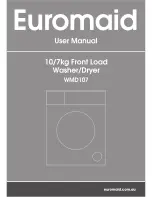
9
ENGLISH
Care and Cleaning
Figure 3
Figure 1
Figure 2
TO REFRESH OR CLEAN INSIDE OF THE WASHER:
IMPORTANT:
Do not load garments or other items in the washer when cleaning
the inside of the washer.
•
Add a 1/2 cup of liquid bleach to the detergent compartment of the dispenser
drawer and fill the bleach dispenser compartment to the Max Fill level and run
WITHOUT a clothes load using the Normal Cycle setting.
For Other Inside Cleaning
•
Before cleaning the washer interior,
unplug the electrical power cord
to avoid
electrical shock hazards.
•
Dry around the washer door opening, flexible gasket, and door glass. These areas
should always be clean to ensure a water tight seal.
•
When extremely soiled items have been washed, a dirty residue may remain on
the drum. Remove this by wiping the drum with a nonabrasive household
cleanser. Rinse thoroughly with water.
•
Periodically, wipe dry the folds in the bottom of the flexible gasket to remove lint
and other debris.
•
The plastic drum vanes may become stained from fabric dye. Clean these parts
with a nonabrasive household cleanser. This prevents dye transfer to future loads.
Cleaning the Dispenser Drawer Area
Detergent and fabric softener may build up in the dispenser drawer. Residue should
be removed once or twice a month.
•
Remove the drawer by pulling the drawer out until it stops. (Figure 1)
•
Reach back into the left rear corner of the drawer cavity and press down firmly
on the lock tab (left rear portion of the drawer). Pull out the drawer. (Figure 2)
•
Remove the insert from the bleach and fabric softener compartments. (Figure 3)
•
Rinse the drawer and inserts with hot tap water to remove traces of accumulated
powders and liquids. Large amounts of fabric softener residue may indicate
improper dilution or more frequent cleaning is required.
•
To clean the drawer opening, use a small brush to clean the recess. Remove all
residue from the upper and lower parts of the recess. (Figure 4)
•
Replace the insert pressing the "X" to lock it in place. Return the dispenser
drawer.
Outside
•
When washing is completed, wipe top and sides of washer with a damp cloth.
Turn water faucets off to prevent pressure build-up in the hoses.
•
As needed, clean the cabinet with mild soap and water.
Never use harsh, gritty
or abrasive cleansers.
If door or console becomes stained, clean with diluted
chlorine bleach [1/2 cup (120 ml) in 1 quart (.95 L) water]. Rinse several times
with clear water.
•
Remove glue residue from tape or labels with a mixture of warm water and mild
detergent. Or, touch residue with the sticky side of the tape or label.
•
When cleaning chrome parts use Windex with ammonia or any of the cleaning
items mentioned for cleaning the cabinet.
•
Before moving the washer,
place a strip of cardboard or thin fiberboard under
the front leveling legs to prevent floor damage.
Winterizing Instructions
If the washer is stored in an area where freezing can occur or moved in freezing
temperatures, follow these winterizing instructions to prevent damage to the washer:
1.
Turn off water supply faucets.
2.
Disconnect hoses from water supply and drain water from hoses.
3.
Plug electrical cord into a properly grounded electrical outlet.
4.
Add 1 gallon (3.8 L) nontoxic recreational vehicle (RV) antifreeze to empty wash
drum. Close door.
5.
Select the Drain/Spin cycle. Press START and let the washer drain for 1 minute
to drain out all the water. Not all of the RV antifreeze will be expelled.
6.
Press Pause/Cancel twice, unplug electrical power cord, dry off drum interior and
close door.
7.
Remove dispenser drawer. Drain any water in compartments and dry
compartments. Replace drawer.
8.
Store washer in an upright position.
9.
To remove antifreeze from washer after storage, run empty washer through a
complete cycle using detergent.
Do not add wash load.
Figure 4
Follow Winterizing
Instructions for cold
weather care.
(Lock tab is visible only after drawer has
been pulled out)
Summary of Contents for ATFB8000F
Page 11: ...11 ENGLISH Warranty English ...





























